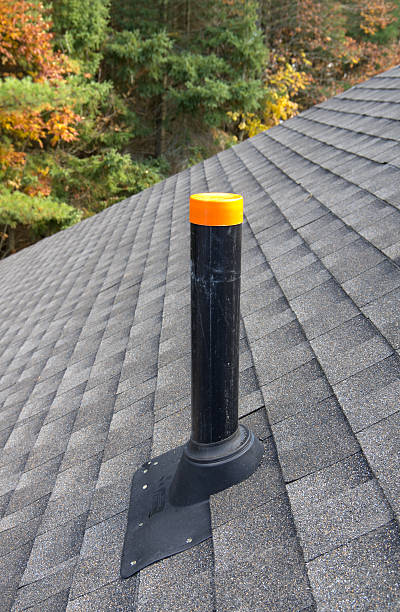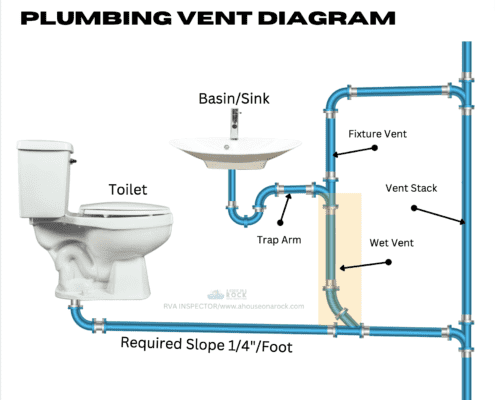Understanding The Importance of Adequate Ventilation in Plumbing Systems
Understanding The Importance of Adequate Ventilation in Plumbing Systems
Blog Article
What're your opinions about What Is A Plumbing Vent & How Do They Work??

Correct ventilation in plumbing systems is typically forgotten, yet it is vital for maintaining the functionality and security of your home's plumbing. Air flow assists manage atmospheric pressure, stop the accumulation of damaging gases, and make sure the reliable removal of waste. In this guide, we will check out the importance of appropriate pipes air flow, exactly how it functions, and the advantages it brings to your pipes system.
Comprehending Ventilation in Plumbing
Air flow in pipes describes the network of pipes that allow air to move with the drain system. These vents offer numerous objectives, including regulating atmospheric pressure within the pipes, stopping sewage system gases from entering the home, and aiding in the smooth flow of wastewater.
Exactly How Ventilation Works in Plumbing Solutions
Air Pressure Regulation
Correct air flow maintains balanced air pressure within the pipes system. When water flows with pipelines, it displaces air. Without sufficient air flow, this variation can develop negative stress, resulting in reduce drains pipes or siphoning of water from traps, which can trigger unpleasant smells to permeate into the home.
Avoiding Drain Gas Build-up
Among the most crucial functions of pipes vents is to stop sewer gases, such as methane and hydrogen sulfide, from building up within the home. These gases can pose severe health and wellness threats and are highly flammable. Vent pipelines allow these gases to get away securely outdoors.
Assisting in Waste Removal
Ventilation assists in the efficient elimination of wastewater by avoiding airlocks in the drainage system. When air can move easily via the vents, it enables water and waste to flow smoothly with the pipes, lowering the threat of clogs and backups.
Sorts Of Pipes Vents
Main Heap Vent
The main stack vent, additionally referred to as the vent pile, is the primary vent in a pipes system. It prolongs from the primary drain line up via the roof, allowing gases to run away and fresh air to go into the system.
Branch Vent
Branch vents connect to the major pile air vent and offer individual components, such as sinks, toilets, and showers. These vents guarantee that each component has ample air flow to operate effectively.
Air Admission Valve (AAV).
An Air Admittance Shutoff (AAV) is a one-way shutoff that permits air to go into the plumbing system without the requirement for a typical air vent pipeline prolonging with the roof. AAVs are generally made use of in renovations or areas where setting up a basic air vent is not practical.
Indications of Poor Ventilation in Plumbing.
Slow Draining Fixtures.
If your sinks, tubs, or toilets are draining slowly, it could be an indicator of inadequate air flow. Insufficient air circulation can produce a vacuum cleaner impact, making it hard for water to drain effectively.
Gurgling Appears.
Gurgling sounds coming from drains are usually an outcome of air being drawn through water catches due to negative pressure in the pipes. This is a clear indicator of not enough ventilation.
Unpleasant Odors.
Sewer odors inside your home are a red flag that your plumbing system is not appropriately aerated. This can imply that drain gases are not being properly vented outside, resulting in potentially dangerous conditions.
Common Air Flow Blunders.
Poor Vent Sizing.
Using small vent pipelines can lead to poor air flow and pressure inequalities in the system. It's essential to make use of vents that meet the certain demands of your plumbing system.
Improper Vent Positioning.
Placing vents as well far from the components they offer can minimize their performance. Correct positioning makes sure that air can move easily and efficiently via the system.
Ignoring Code Demands.
Building ordinance supply specific standards for plumbing air flow. Ignoring these codes can cause a system that fails to function appropriately and may lead to costly repair services or carcinogen.
Advantages of Correct Air Flow.
Improved System Efficiency.
Correctly aerated plumbing systems operate extra successfully, with less obstructions, faster draining pipes, and less pressure on the pipelines. This performance prolongs the life-span of the pipes system.
Improved Air Quality.
By stopping sewer gases from entering your home, appropriate air flow contributes to far better indoor air top quality, making your living environment healthier and extra comfortable.
Avoiding Water Damages.
Adequate air flow assists prevent water from being siphoned out of traps, which can bring about sewer gases going into the home and creating water damages over time.
Actions to Make Certain Appropriate Air Flow.
Consulting Plumbing Codes.
Always consult local pipes codes when designing or changing your plumbing system. These codes supply the necessary guidelines for appropriate venting and ensure your system satisfies safety criteria.
Routine Assessment and Upkeep.
Regular assessments can assist identify prospective air flow issues prior to they end up being significant issues. Upkeep jobs, such as cleaning vent pipes and checking for obstructions, are necessary for keeping the system in good working order.
Specialist Setup.
For brand-new installations or significant adjustments, it's smart to hire a specialist plumbing technician. They have the knowledge to ensure the ventilation system is appropriately made and installed according to code.
Final thought.
Appropriate air flow is a critical component of any pipes system, making certain that it works effectively and safely. By recognizing the relevance of air flow, identifying the indicators of inadequate air flow, and taking steps to maintain your system, you can prevent pricey problems and secure your home's air quality.
4 Things You Should Know About Your Plumbing Vents
What Plumbing Vents Are
Also called a vent stack, a plumbing vent is a vertical pipe attached to your drain line that runs through your roof. The plumbing vent pipe, or plumbing air vent, removes gas and odors from your plumbing system and allows fresh air to enter the pipes, helping the water to flow out of the drain pipes.
What Plumbing Vents Do
Plumbing vents have two basic functions. One of which is to allow unpleasant smelling wastewater and sewer gasses to escape your plumbing system instead of entering your home. Plumbing vent pipes are typically located on roofs, away from windows, to ensure the fumes exit the home completely.
The other function of the plumbing vent is to move fresh air into your plumbing system. This helps move water through every plumbing fixture in your house, like toilets and sink drains. Think of the way in which you need to let a little air into the bottle as you pour soda in order to make the drink flow smoothly.
Different Types of Plumbing Vents
True vent: This is the most common vent option. In simplest terms, a true vent is a vertical pipe attached to your drain line that exits through the roof. They often function as the main vent that other fixtures can connect to. Re-vent pipe or auxiliary vent: Attached to the drain line near specific plumbing fixtures, re-vent pipes run up and over to connect to the main vent. Common vent: Two plumbing fixtures installed on opposite sides of a wall are typically tied into the vent stack using something known as a sanitary cross. Wet vent: This venting option operates as a drain pipe and a vent at the same time. Wet vent drainage systems drain water from one fixture while venting the air from another. Although they’ve been used for over 100 years, wet vent systems have only recently been added to the plumbing code in many areas. If you’re planning on installing one in a bathroom remodel, make sure you check your local code prior to construction. Loop vent: For free-standing fixtures like kitchen island sinks, loop vents are ideal. These vent pipes run under the floor, rise from the P-trap, and create a loop inside the cabinet sink. Air admittance valve: An AAV is a one-way mechanical valve typically installed at the site of the plumbing fixture. AAVs allow venting to occur without having to tie into a larger venting system. They’re ideal for venting fixtures where you aren’t able to easily connect to an existing vent system. Common Plumbing Vent Issues
Although vent pipes typically don’t have water flowing through them, they’re still subject to many typical plumbing issues. For example, clogs are one of the most common problems associated with sewer vent pipes. If your vent pipe gets clogged, all of your plumbing fixtures tied into the vent stack will be affected.
A sink with a slow drain that bubbles and gurgles or a strong sewage smell around your toilet are both indicators that your toilet vent pipe is clogged. Because most vent pipes exit through the roof, old leaves, twigs or even a bird’s nest could be clogging the pipe.
Clogs in your vent pipe system cause a buildup of negative pressure, meaning that water won’t be able to flow out of your home very well. It’s similar to putting your finger over the opening of a straw to trap water inside. When you remove your finger, the water is able to flow out of the straw.
If you suspect you have any blockage in your vent, make sure you have a professional come examine the situation. Left unchecked, a blocked air vent can lead to other costly repairs, like leaks and sediment buildup.
Under Pressure
Pipe vents are essential aspects of a home’s plumbing system. Owning a home means learning about all sorts of things you never put much thought into before. But by understanding as much as you can about the important systems of your home, you can keep those budgets intact and those anxiety levels low.
https://www.homeserve.com/en-us/blog/home-improvement/plumbing-vents/

I was shown that write-up on What Is A Plumbing Vent & How Do They Work? through an acquaintance on a different website. Enjoyed our blog? Please quickly share it. Help somebody else check it out. Thanks a lot for going through it.
Call Today Report this page